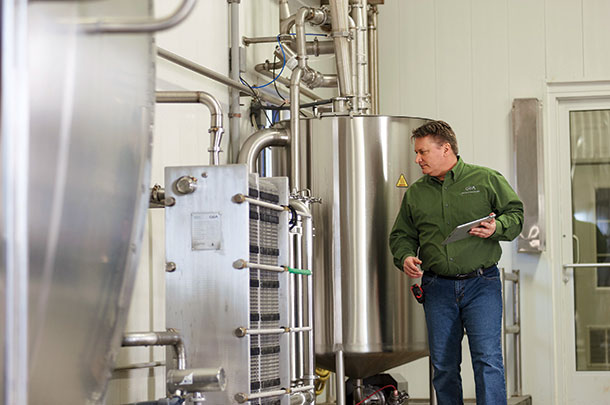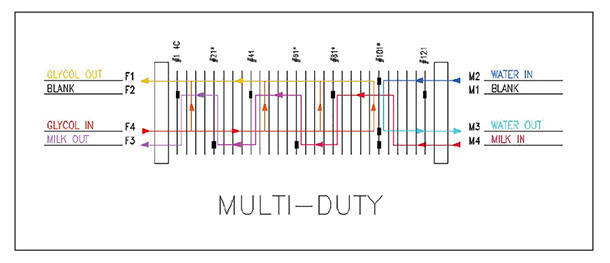A milk cooling system is an essential element of any dairy operation. There is no way around it; if you milk cows, you need a milk cooling system, as it decreases the chance for bacteria growth in milk.
That said, milk cooling systems can also be a huge drain on your resources.
To increase energy efficiency as well as capacity to cool milk, plate heat exchangers can offer an alternative solution to existing cooling systems.
Energy savings
One of the biggest downfalls of a milk cooling system is the massive amount of electricity used. Thirty to 40 percent of the total energy consumption on a farm comes from the milk cooling process alone. Installing a plate heat exchanger can provide a huge advantage in energy savings.
By utilizing well water to initially cool milk, plate heat exchangers can reduce the need for mechanical refrigeration by 40 to 50 percent. Not only does this reduce your energy consumption, it also decreases the load on your refrigeration system, increasing the lifespan of the equipment.
Many dairies take advantage of additional savings by utilizing the wastewater discharged from the plate cooler in other areas of the farm.
Quick cooling
The goal of any cooling system is to cool milk to less than 45ºF within the first hour after milking. As many farms look to increase their cow numbers, milk flow rates start to exceed what a bulk tank can cool in the proper amount of time. The easiest way to get additional cooling is installing a plate heat exchanger.

This instant cooling process also has added benefits for milk quality. Milk coming from the cow at 98ºF is a breeding ground for bacteria and contaminants – and can decrease milk quality if not cooled quickly enough.
The quick cooling of a plate heat exchanger is essential to decreasing the chance of bacteria growth in the milk.
Size matters
The proper size is critical to get the most efficiency from your plate heat exchanger. If you don’t have the right amount of surface area for the incoming milk flow, milk cooling efficiency decreases greatly.
With too small equipment, there isn’t enough water flowing through the plates to properly cool milk. Heat exchange between the milk and water will decrease, and your milk temperature can increase by 15 to 20ºF during the initial cooling phase.
This means increased cooling needs to be handled by your refrigeration system, resulting in increased energy use.
Correctly sized plate heat exchangers can cool milk to within 5ºF of well water temperature. A good rule of thumb to follow is: 2 gallons of water for every gallon of milk flowing through the plate heat exchanger.
Cleaning and maintenance
Improperly cleaned equipment can cause a decrease in cooling efficiency, negatively impacting your bottom line.
Plate heat exchangers should be sized to fit with your clean-in-place system for optimum washwater flow. If the plate heat exchanger is too small, washwater can’t properly flow through the plates, which can cause a build-up of bacteria and decrease milk quality.
In addition to daily cleanings, clean the water side of the plate heat exchanger periodically. Build-up can occur from high levels of iron or hardness in the water, causing water flow to decrease and resulting in a loss of up to 10ºF in the initial cooling process.
To maintain efficiency, clean the water side of the plate heat exchanger, at a minimum, once every year. Depending on water quality, you may need to run a cleaning cycle every three months.
Work with your cooling specialists to ensure you are getting the most from your plate heat exchanger to increase efficiency and capacity of your cooling system. ![]()
PHOTO 1: Plate heat exchangers provide increased capacity and efficiency for any milk cooling system.
PHOTO 2: Proper sizing of the plate heat exchanger is essential for efficiency. Work with your cooling specialist to determine the correct size for your milk flow. Photos courtesy of GEA Farm Technologies.
Kevin Kastenschmidt is a cooling and sales specialist with GEA Farm Technologies. Email Kevin Kastenschmidt.

How it works
Plate heat exchangers, also called plate coolers, cool milk by transferring heat from the milk into water flowing through the plates in the opposite direction as milk is coming in.
Depending on the temperature of your water, 40 to 50 percent of cooling can be achieved without using mechanical refrigeration.
Two main ways to use plate heat exchangers are:
-
Single-duty plate heat exchanger: Milk passes through the plate heat exchanger transferring heat through the use of well water. The remaining cooling process is achieved through mechanical refrigeration in the bulk tank.
- Multi-duty plate heat exchanger: In addition to the initial cooling with well water, a multi-duty system has a second stage of cooling. A chilled glycol solution flows through the plate heat exchanger, cooling milk to 36ºF. This process is typically used with a direct-load system where milk is immediately transferred to a tanker for transporting rather than a bulk tank.





